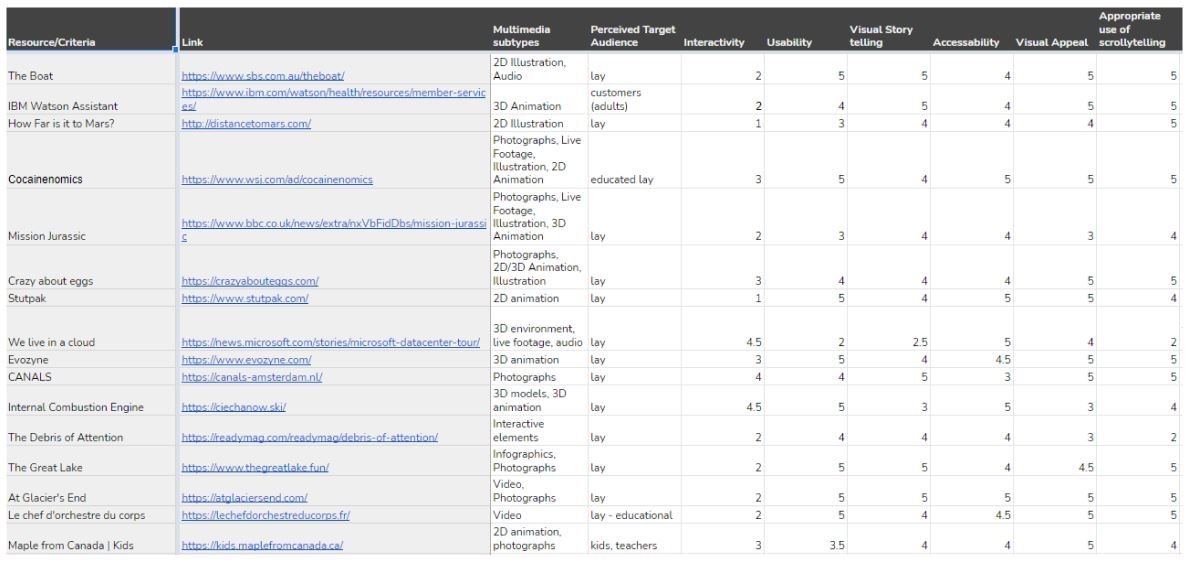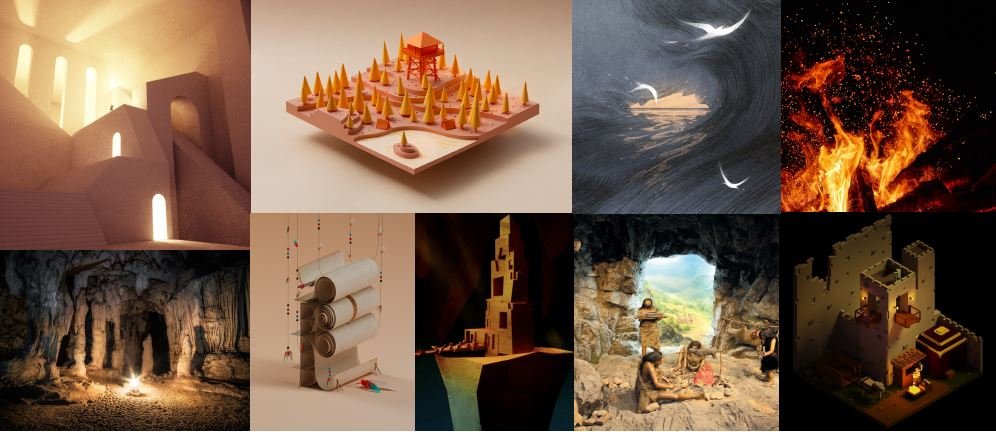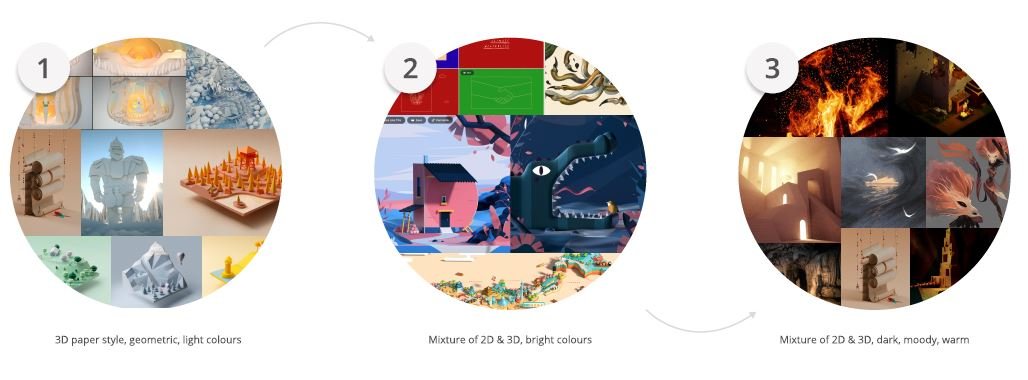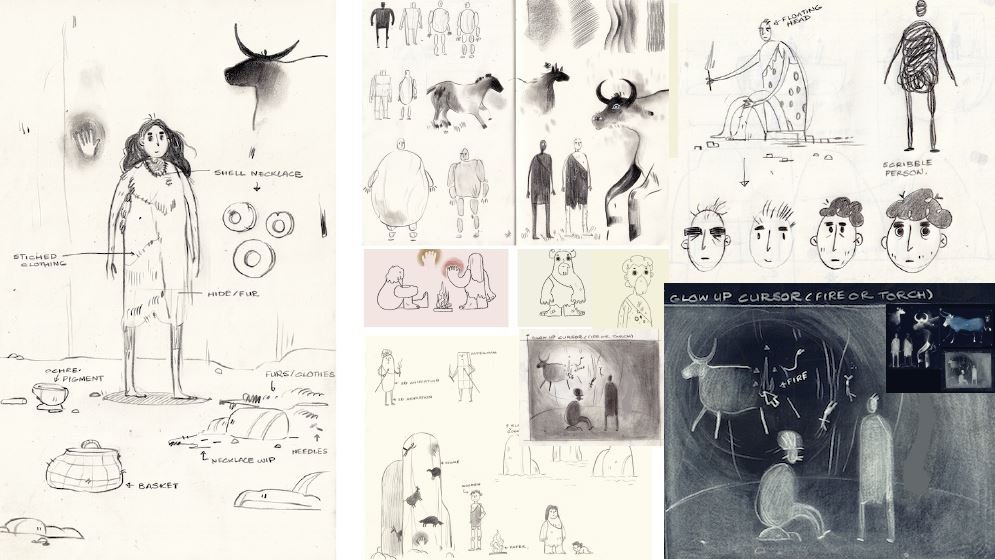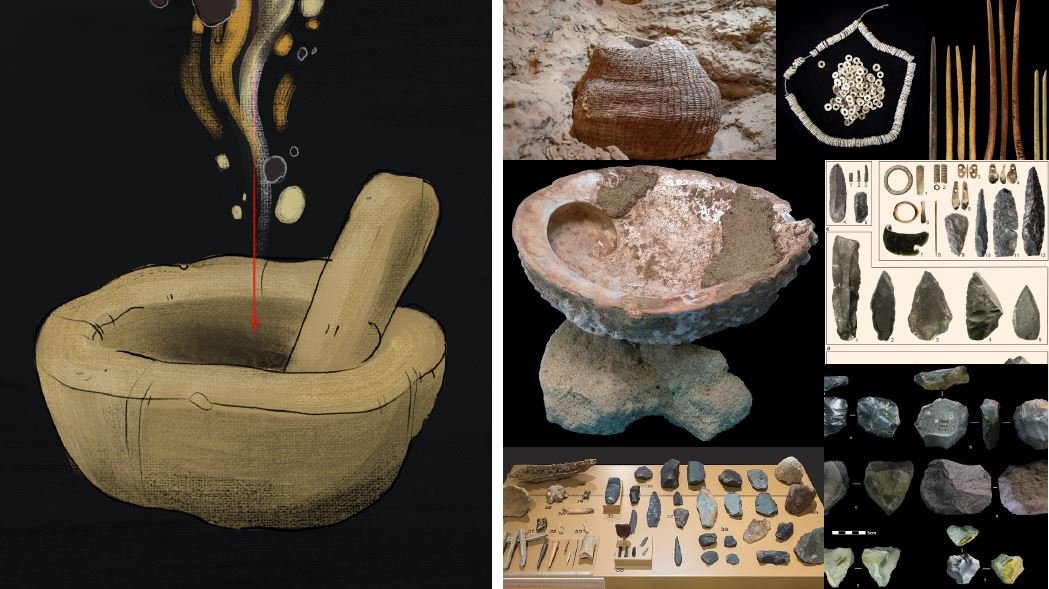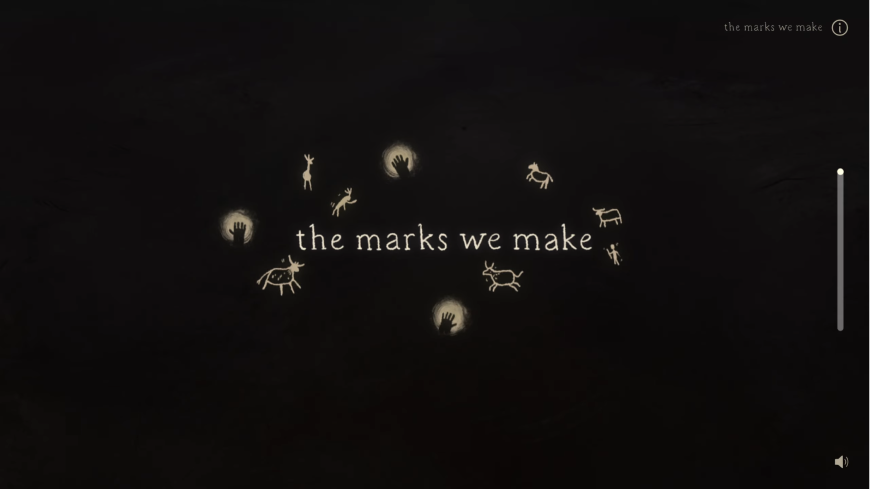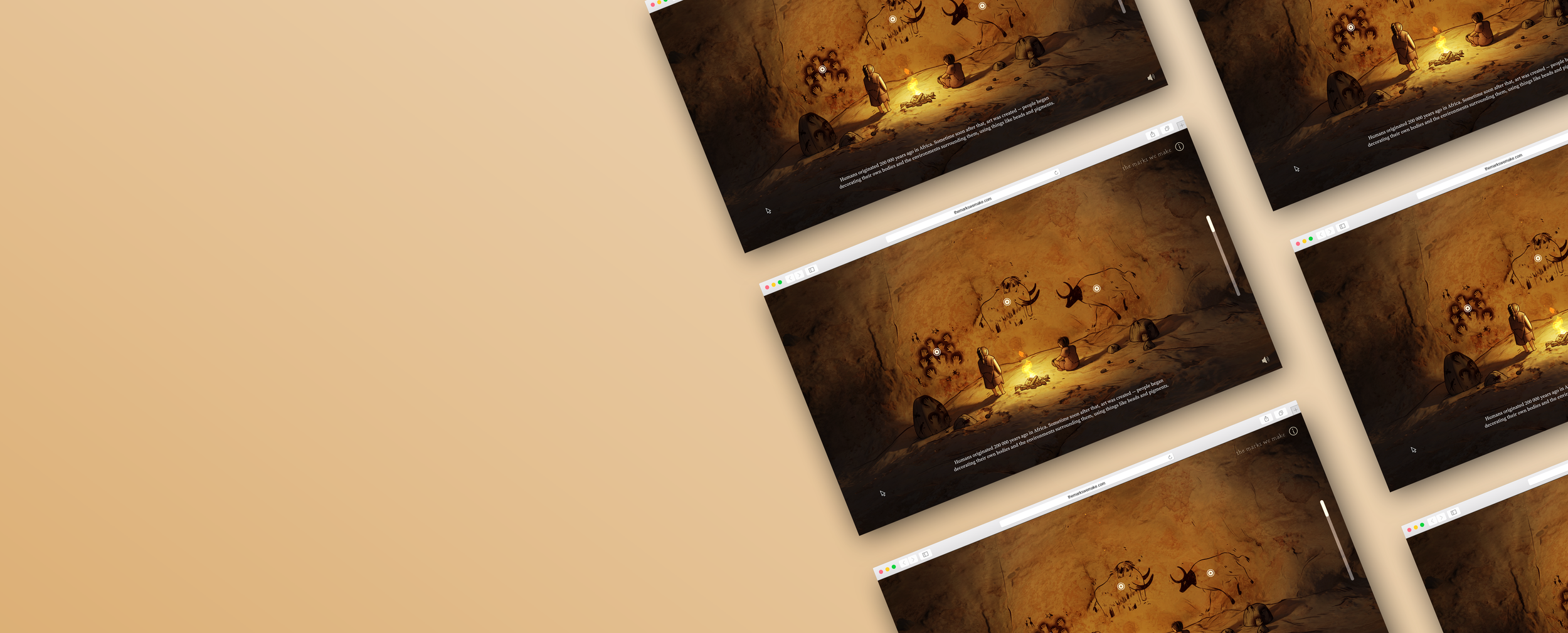
The Marks We Make
Purpose
The Marks We Make is a delightful interactive scrollytelling experience about the history of cave art. This project evolved from the desire to explain the history of communication over the ages, into a passion project about the earliest marks we have a record of. It was originally intended to be solely informative and slowly developed into a philosophical piece that would leave the user in a state of self-reflection.
Team
Amy Assabgui
Aimy Wang
Shay Saharan
Role
Writer & Researcher, Designer, Draft Storyboard Artist, 3D Animator, Sound Designer
Date
April 2022
Target Media
Scrollytelling website
Tools
Figma, Photoshop, Procreate, Blender, After Effects
Primary Audience
Lay
Project Plan Overview
The project was split into several key stages: Media Audit, Broad Research, Content Outline, Visual Development, Storyboard, and Development. A timeline and roles and responsibilities was also created at the beginning of the project.
Media Audit
In preparation for this project, we conducted a media audit that examined examples of scrollytelling websites across the internet. We ranked each website based on seven criteria: multimedia subtypes used, interactivity, usability, effectiveness of visual media, accessibility, visual appeal, and credibility. Considerations included the appropriate use of the medium, the effectiveness of information conveyance, creativity, and ease of navigation. In addition to the scrollytelling audit, we did a preliminary scan of online media surrounding the history of communication, including websites and video, with the main findings being infographics that contained a very surface level and broad overview of the topic.
Ideation
After conducting the media audit of current resources surrounding the topic of the history of communication, we realized that this topic was too broad; we ultimately narrowed down the topic to the history of cave art instead. After selecting topics of focus, an additional media audit was conducted for current media surrounding our topic but did not find any comparable works online. This led us to begin narrowing down our research and creating a script for our piece,
Visual Inspiration
The overall visual feel of The Marks We Make is dark, fiery, and moody, yet warm and welcoming. It invites the user in and fills them with a sense of comforting curiosity. This look and feel was inspired by the sensation of sparks flying in the air and was ultimately selected as it embodies the feeling of being in a fire-lit cave. The dark and light contrast is paired with natural and earth-toned colours to give the feeling of warmth, and to mimic the natural cave environment.
Visual Development
The environment was heavily inspired by images of fires in caves, sparks in the sky, stars, and drawings found on cave walls. In terms of characters, many different character iterations were created, from simple shaded silhouettes to highly stylized cave people with exaggerated proportions. The selected character design was one that takes on a sketchy style that mimics the feeling of early cave paintings.
Storyboarding
The storyboard began as a focus group discussing possible visual treatments based off the script. It then progressed into sketching sprints to visually depict treatment ideas for each section of the story. Specific panels were selected and organized into a rough draft of the story. These panels were then cleaned up and made into a visually consistent black and white draft. Once feedback was obtained from friends, colleagues, and family, alterations were made and a final colour storyboard was created. Please refer to the appendix to view the black and white storyboard draft and initial feedback.
Development
2D & 3D Scenes
The final look and feel for The Marks We Make is a combination of 2D and 3D elements. The feeling is dark and ominous, with a youthful and playful twist. To achieve this 2D/3D hybrid look, the entire scene was created in 3D using Blender. This includes the cave background, rocks, characters, and any other props such as the firewood. The render was given a 2D overlay with outlines to accentuate the 3D features, and drawings and detail were added to the cave wall and rocks. These overlays were originally created in Adobe Photoshop, then composited with the 3D animation in Adobe After Effects. This integration of 3D and 2D is intended to carry on throughout the remainder of the experience.
Opening and Text Scenes
The opening scene is entirely 2D, with assets created in Adobe Photoshop and later animated using Adobe After Effects. Scenes solely containing text are also entirely 2D, with assets created in Adobe Photoshop and later animated using Adobe After Effects. This allows for maximum readability of text, and also allows scenes with 3D elements to be integrated seamlessly with one another.
UI Design
The overall user interface is designed to be simple and intuitive. White text and light coloured elements were chosen to contrast against the dark background. Components are kept simple with a hand-drawn look to complement the visual style of the piece.
Sound Design
Sound is used to create a meditative ambiance that invites exploration. The various layers of sound create the feeling of being in a cave environment, and provide auditory feedback for the user’s actions.
Design Document
All of the documentation for the project can be found in our design document, which you can read below, or access here.
References
Aubert, M., Lebe, R., Oktaviana, A. A., Tang, M., Burhan, B., Jusdi, A., ... & Brumm, A. (2019). Earliest hunting scene in prehistoric art. Nature, 576(7787), 442-445.
Clottes, J. (2020, May 22). Cave art. Encyclopedia Britannica. https://www.britannica.com/art/cave-paintingCallaway, E. (2019). Is this cave painting humanity’s oldest story? Nature. doi:10.1038/d41586-019-03826-4
Cardello, J. (2019, August 29). A beginner's guide to scrollytelling: Webflow Blog. Retrieved November 11, 2021, from https://webflow.com/blog/scrollytelling-guide
D'Arcy, P., & Zuabi, A. N. (2020, April 16). What the mysterious symbols made by early humans can teach us about how we evolved. Retrieved August 15, 2021, from https://ideas.ted.com/what-the-mysterious-symbols-made-by-early-humans-can-teach-us-about-how-we-evolved/
Dissanayake, E. (2016). Mark-Making as a Human Behavior. Darwin's Bridge, 101-130. doi:10.1093/acprof:oso/9780190231217.003.0007
Elhacham, E., Ben-Uri, L., Grozovski, J., Bar-On, Y. M., & Milo, R. (2020). Global human-made mass exceeds all living biomass. Nature, 588(7838), 442-444.
Encyclopædia Britannica, inc. (n.d.). Paleolithic settlement. Encyclopædia Britannica. Retrieved September 10, 2021, from https://www.britannica.com/topic/history-of-Europe/Paleolithic-settlement#ref58233.
Guarino, B. (2019, December 11). The oldest story ever told is painted on this cave wall, archaeologists report. Washington Post. Retrieved August 16, 2021, from https://www.washingtonpost.com/science/2019/12/11/oldest-story-ever-told-is-painted-this-cave-wall-archaeologists-report/
Kosara, R. (2016, May 23). The Scrollytelling Scourge. Retrieved November 11, 2021, from https://eagereyes.org/blog/2016/the-scrollytelling-scourge
Krause, R. (2019, April 28). 6 Rules for Persuasive Storytelling - Nielsen Norman Group. Retrieved from https://www.nngroup.com/articles/persuasive-storytelling/
Marris, E. (2018). Neanderthal artists made oldest-known cave paintings. Nature. doi:10.1038/d41586-018-02357-8Morriss-Kay, G. M. (2010). The evolution of human artistic creativity. Journal of Anatomy, 216(2), 158–176. https://doi.org/10.1111/j.1469-7580.2009.01160.x
Mott, J., & Marchant, J. (2016, Jan. & Feb.). A Journey to the Oldest Cave Paintings in the World. Retrieved from https://www.smithsonianmag.com/history/journey-oldest-cave-paintings-world-180957685/
National Geographic: Cave Art 101. (2018, April 15). Retrieved August 16, 2021, from https://www.youtube.com/watch?v=ZjejoT1gFOc
Neubauer, S., Hublin, J., & Gunz, P. (2018). The evolution of modern human brain shape. Yearbook of Paediatric Endocrinology. doi:10.1530/ey.15.14.6
Pringle, H. (2021, May 03). Mysterious Markings May Hold Clues to Origin of Writing. Retrieved August 15, 2021, from https://www.nationalgeographic.com/history/article/cave-art-ice-age-paleolithic-writing-first-signs?loggedin=true
Stone, M. (2021, May 03). Human-made materials now equal weight of all life on Earth. Retrieved August 15, 2021, from https://www.nationalgeographic.com/environment/article/human-made-materials-now-equal-weight-of-all-life-on-earth
Prehistoric pigments. RSC Education. (2015, October 1). https://edu.rsc.org/resources/prehistoric-pigments/1540.article.
Schneiders, P. (2020). What Remains in Mind? Effectiveness and Efficiency of Explainers at Conveying Information. Media and Communication, 8(1), 218-231. doi:10.17645/mac.v8i1.2507
Seyser, D., & Zeiller, M. (2018). Scrollytelling – An Analysis of Visual Storytelling in Online Journalism. 2018 22nd International Conference Information Visualisation (IV). doi:10.1109/iv.2018.00075
Shander, B. (2020, August 25). The Past, Present, and Future of Scrollytelling. Retrieved November 11, 2021, from https://medium.com/nightingale/the-past-present-and-future-of-scrollytelling-10dd37dc1003
Skretvedt, Randy. “Radio.” Encyclopædia Britannica, Encyclopædia Britannica, Inc., 27 July 2021, www.britannica.com/topic/radio.
Steffen, W., Broadgate, W., Deutsch, L., Gaffney, O., & Ludwig, C. (2015). The trajectory of the Anthropocene: The Great Acceleration. The Anthropocene Review, 2(1), 81-98. doi:10.1177/2053019614564785
Von Petzinger, G. (2017). The first signs: Unlocking the mysteries of the world's oldest symbols. Simon and Schuster.
Waters, C. N., Zalasiewicz, J., Summerhayes, C., Barnosky, A. D., Poirier, C., Ga Uszka, A., . . . Wolfe, A. P. (2016). The Anthropocene is functionally and stratigraphically distinct from the Holocene. Science, 351(6269). doi:10.1126/science.aad2622
Zaidel, D. W. (2010). Art and brain: Insights from neuropsychology, biology and evolution. Journal of Anatomy, 216(2), 177-183. doi:10.1111/j.1469-7580.2009.01099.x
